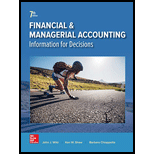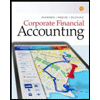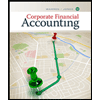
Financial and Managerial Accounting
7th Edition
ISBN: 9781259726705
Author: John J Wild, Ken W. Shaw, Barbara Chiappetta Fundamental Accounting Principles
Publisher: McGraw-Hill Education
expand_more
expand_more
format_list_bulleted
Concept explainers
Textbook Question
Chapter 5, Problem 3E
Exercise 5-3 Perpetual: Inventory costing methods P1
Laker Company reported the following January purchases and sales data for its only product.
| Date | Activities | Units Acquired at Cost | Units Sold at Retail |
| Jan 1 | Beginning inventory……………… | 140 units @ $6.00=$ 840 | |
| Jan 10 | Sales …………………………….. | 100 units @ $ 15 | |
| Jan 20 | Purchase ……………………….. | 60 units @ $ 5.00 = 300 | |
| Jan 25 | Sales ……………………………. | 80 units @ $ 15 | |
| Jan 30 | Purchase ……………………….. | 180 units @ $4.50 = 810 | _______ |
| Totals ………………………….. | 380 units $1,950 | 180 units |
Required
The company uses a perpetual inventory system. Determine the cost assigned to ending inventory and to cost of goods sold using (a) specific identification, (b) weighted average, (c) FIFO, and (d) LIFO. (Round per unit costs and inventory amounts to cents.) For specific identification, ending inventory consists of 200 units, where 180 are from the January 30 purchase, 5 are from the January 20 purchase, and 15 are from beginning inventory.
Expert Solution & Answer
Want to see the full answer?
Check out a sample textbook solution
Students have asked these similar questions
No WRONG ANSWER
General accounting 5.7
Don't Use Ai
Chapter 5 Solutions
Financial and Managerial Accounting
Ch. 5 - Prob. 1MCQCh. 5 - Prob. 2MCQCh. 5 - Prob. 3MCQCh. 5 - Prob. 4MCQCh. 5 - Prob. 5MCQCh. 5 - Prob. 6MCQCh. 5 - Describe how costs flow inventory to cost of goods...Ch. 5 - Where is the amount of merchandise inventory...Ch. 5 - Why are incidental costs sometimes ignored in...Ch. 5 - Prob. 4DQ
Ch. 5 - Prob. 5DQCh. 5 - Prob. 6DQCh. 5 - Prob. 7DQCh. 5 - Prob. 8DQCh. 5 - Prob. 9DQCh. 5 - Prob. 10DQCh. 5 - Prob. 11DQCh. 5 - What factors contribute to (or cause) inventory...Ch. 5 - Prob. 13DQCh. 5 - Prob. 14DQCh. 5 - Prob. 15DQCh. 5 - Prob. 16DQCh. 5 - Prob. 17DQCh. 5 - Prob. 1QSCh. 5 - Prob. 2QSCh. 5 - Prob. 3QSCh. 5 - Perpetual: Inventory costing with FIFO P1 A...Ch. 5 - Prob. 5QSCh. 5 - Prob. 6QSCh. 5 - Prob. 7QSCh. 5 - Prob. 8QSCh. 5 - A Periodic: Inventory costing with weighted...Ch. 5 - Prob. 10QSCh. 5 - Prob. 11QSCh. 5 - Perpetual: Inventory costing with weighted average...Ch. 5 - Prob. 13QSCh. 5 - Prob. 14QSCh. 5 - Prob. 15QSCh. 5 - Prob. 16QSCh. 5 - Prob. 17QSCh. 5 - Prob. 18QSCh. 5 - Prob. 19QSCh. 5 - Prob. 20QSCh. 5 - Prob. 21QSCh. 5 - Prob. 22QSCh. 5 - Prob. 23QSCh. 5 - Prob. 1ECh. 5 - Prob. 2ECh. 5 - Exercise 5-3 Perpetual: Inventory costing methods...Ch. 5 - Prob. 4ECh. 5 - Prob. 5ECh. 5 - Prob. 6ECh. 5 - Prob. 7ECh. 5 - Prob. 8ECh. 5 - Prob. 9ECh. 5 - Prob. 10ECh. 5 - Prob. 11ECh. 5 - Prob. 12ECh. 5 - Prob. 13ECh. 5 - Prob. 14ECh. 5 - Prob. 15ECh. 5 - Prob. 16ECh. 5 - Prob. 17ECh. 5 - Prob. 18ECh. 5 - Prob. 1PSACh. 5 - Prob. 2PSACh. 5 - Prob. 3PSACh. 5 - Problem 5-4AA Periodic: Alternative cost flows...Ch. 5 - Prob. 5PSACh. 5 - Prob. 6PSACh. 5 - Prob. 7PSACh. 5 - Prob. 8PSACh. 5 - Prob. 9PSACh. 5 - Prob. 10PSACh. 5 - Prob. 1PSBCh. 5 - Prob. 2PSBCh. 5 - Prob. 3PSBCh. 5 - Prob. 4PSBCh. 5 - Prob. 5PSBCh. 5 - Prob. 6PSBCh. 5 - Prob. 7PSBCh. 5 - Problem 5-8BA Periodic: Income comparisons and...Ch. 5 - Prob. 9PSBCh. 5 - Prob. 10PSBCh. 5 - Prob. 5SPCh. 5 - Prob. 1BTNCh. 5 - Prob. 2BTNCh. 5 - Prob. 3BTNCh. 5 - Prob. 4BTNCh. 5 - Prob. 5BTNCh. 5 - Prob. 6BTNCh. 5 - Prob. 7BTNCh. 5 - Prob. 8BTNCh. 5 - Prob. 9BTN
Knowledge Booster
Learn more about
Need a deep-dive on the concept behind this application? Look no further. Learn more about this topic, accounting and related others by exploring similar questions and additional content below.Similar questions
- The cost of goods sold of rick company for the period is?arrow_forwardgeneral accounting questionarrow_forwardCompute the net income or net loss for the month ended on March 31, 2008, from the following data: Assets on March 1, 2008 $ 40,000 Liabilities on March 1, 2008, 30,000 Capital on March 31, 2008, 15,000 Additional investments by the owner during the year 2008 2,000 Withdrawals during the year 2008 1,000 A. $3,000 B. $4,000 C. $5,000 D. $6,000arrow_forward
arrow_back_ios
SEE MORE QUESTIONS
arrow_forward_ios
Recommended textbooks for you
 Corporate Financial AccountingAccountingISBN:9781305653535Author:Carl Warren, James M. Reeve, Jonathan DuchacPublisher:Cengage Learning
Corporate Financial AccountingAccountingISBN:9781305653535Author:Carl Warren, James M. Reeve, Jonathan DuchacPublisher:Cengage Learning Corporate Financial AccountingAccountingISBN:9781337398169Author:Carl Warren, Jeff JonesPublisher:Cengage Learning
Corporate Financial AccountingAccountingISBN:9781337398169Author:Carl Warren, Jeff JonesPublisher:Cengage Learning AccountingAccountingISBN:9781337272094Author:WARREN, Carl S., Reeve, James M., Duchac, Jonathan E.Publisher:Cengage Learning,
AccountingAccountingISBN:9781337272094Author:WARREN, Carl S., Reeve, James M., Duchac, Jonathan E.Publisher:Cengage Learning,

Corporate Financial Accounting
Accounting
ISBN:9781305653535
Author:Carl Warren, James M. Reeve, Jonathan Duchac
Publisher:Cengage Learning

Corporate Financial Accounting
Accounting
ISBN:9781337398169
Author:Carl Warren, Jeff Jones
Publisher:Cengage Learning

Accounting
Accounting
ISBN:9781337272094
Author:WARREN, Carl S., Reeve, James M., Duchac, Jonathan E.
Publisher:Cengage Learning,
Chapter 6 Merchandise Inventory; Author: Vicki Stewart;https://www.youtube.com/watch?v=DnrcQLD2yKU;License: Standard YouTube License, CC-BY
Accounting for Merchandising Operations Recording Purchases of Merchandise; Author: Socrat Ghadban;https://www.youtube.com/watch?v=iQp5UoYpG20;License: Standard Youtube License